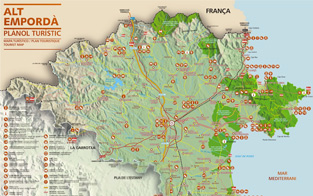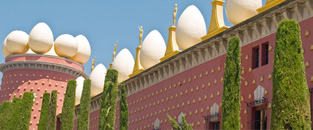
Figueres
Figueres is the capital of the region of Alt Empordà. It has a long hub for travelers.The city became known as the birthplace of the painter Salvador Dalí. The town offers visitors a wide range of cultural activities and events throughout the year.
Sights
- Fortress de Sant Ferran, the fortress was built in the XVIII century by the Bourbons, as a protection against the French. The fortress extends on the outskirts of Figueres an area of 5.5km and a circumference of 3km. The complex has a large cistern, which once made the fortress independent of the external water supply. Today it is possible to visit this cistern with small boats. The completion of this fortress lasted for almost 13 years. In 1997, the facility was made available to the public.
- The Rambla of Figueres is the heart piece, of the city. It is the venue for various cultural events. Originally flows under the Rambla the river Gallingen, which was covered in the 18th century due to hygiene reasons.
- Church Sant Pere. In addition to the Dalí Museum is the church of Sant Pere. A religious monument late 14th century. The building was built in different periods, but has a surprisingly uniform style.
- The Dalí Theatre-Museum was inaugurated in 1974 and built on the remains of the former municipal theatre of Figueres. The museum contains a variety of works by Salvador Dalí 1904-1989. From his early artistic and drawings to production from the time of surrealism to the works of his last years. The museum was designed by the artist Salvador Dali himself. In summer the museum offers his visitors also tours at night.
- The Toy Museum. The museum offers visitors a great exhibition of toys from different centuries. Your kids will love it.
- Culture Museum of the Empordà. At the museum of the Empordà visitors can visit an archeological collections of history, culture and discover as well the lifestyle and traditional dance of Catalonia.
Events
- L’Acústica
- Festa Major
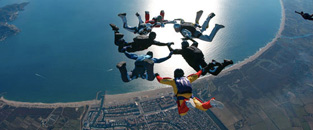
Castelló d’Empuries y Empuriabrava
Castelló d’Empuries is a medieval village.It is surrounded by the natural park Aiguamolls d’Empordà, near the confluence of the river Muga in the Golf of Roses.
Its unique location allows the traveler an ideal combination of culture, beach and nature. The place can be divided into 2 areas:
The town of Castelló d’Empuries still retains its medieval charm. The village has a great wealth of monuments and a Jewish quarter, which is in Catalonia next to Girona one of the most important. The history of the village was recorded by numerous documents, which allowed to interpret the numerous architectural sights of the village.
Sights
- Gothic Basilica of Santa Maria (XIV century). The basilica is gothic origin, their structure has the dimensions of a cathedral. The basilica is one of the most interesting catholic buildings in Catalonia. The construction began in the XIII century continued in the XIV century and finished in the XV century
- The medieval bridge “Pont Vell”. The medieval bridge, is located across the river la Muga, next to the old district Sant Marc. It was built in the XIV century, during the term of office of Pere I. The bridge had a few times to be rebuilt again, because of floods and wars.
- The Convent of Santa Clara (XI century). The convent of nuns of Clarissa Castelló d’Empuries was founded in 1260 outside the city walls. In the end of the XVI century, the convent was moved to the village center, since it was destroyed during the war.
- Sinagoga. The former synagogue is located in the street “Peixateries Velles”. Previously this building was a school and the Synagogue for the Jewish population, who lived at this time in the village. This synagogue was first documented in the year XII.
- The Basin. The public washing place was built in the XIX century, this place has fregmente of tuscan columen from the old convent of San Francesc, which was located there in 1264.
- Court and prison. The building was built in 1336. This building served as the 2 things at the same time. As a Court by the law was enforced and as a prison by the convicts had to serve your sentence. The complex was feared by everyone and radiated by the power of Condals. The Prison of Castelló d’Empuries is unique in all of Catalonia.
- Ecomuseum. The milling is located next to the brook of the village. It is one of three medieval windmills of the city. It is a large industrial building with three floors built in 1905.
You can see the old machinery, mostly in wood, which have been partly renovated in the middle of the twentieth century. Today, the museum shows the history as grain is processed into flour.
Events
- Fiesta Medieval
- Festa Major
- Ruta de l’Art
- Festa del Carmen (Empuriabrava)
Empuriabrava is part of the community Castelló d’Empúries. The settlement is located two kilometers from Castelló d’Empúries and was founded in 1967. Empuriabrava has the largest marina in Europe. A characteristic feature of the townscape is a grid-like scale network of navigable channels with a total of over 30 kilometers in length.
The Marina of Empuriabrava is not only famous for its canals, but also through various activities that you can experience there, such as:
- Skydive
- Wind Tunel
- Boattrip through the canals
- Kitesurf, windsurf, Paddle surf
- Kayak
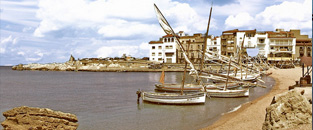
L’Escala y St. Martí d’Empuries
L’Escala is a small fishing village which was founded in the 16th century and located in the southern part of the Bay of Roses and the northeast of Catalonia in the province of Girona.
L’Escala has a picturesque old town as well as a modern center (Riells) with a shopping street at the beach promenade. In the north, district Sant Marti is placed under protection.
St. Martí d’Empuries
Is part of a medieval village, which belongs to the municipality of L’Escala. The village is situated on the seafront just 500 meters from the famous Greco-Roman ruins of Ampurias. Between the eighth and eleventh centuries, was Sant Martí d’Empuries d’Empúries the county until the Count decided to move the capital to Castelló d’Empuries. It is still surrounded by the original walls and throne on a hill from which one has a breathtaking view over the dunes.
Las Ruinas d´Empúries
The ruins of St Martí d’Empuries is a world famous archaeological site. It is one of the most important archaeological sites in Catalonia.
The city was founded by the Greeks in the 6th century. Chr., Founded and later populated by the Romans, in the 1st century BC. Chr, in the same place docked own settlement.
This part of the Costa Brava possessed thanks to its major trading connections to the 3rd century AD. Chr. In a strategic location, the city, however, was abandoned and disappeared beneath the dunes. For centuries, this remained impressive archaeological treasure in concealment. The excavations of Empúries were started in 1900 and are still not complete.
Events
- Fiesta de la Sal
- Festa Mejor
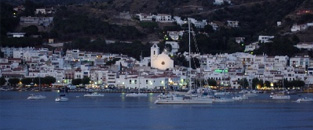
Port de la Selva
The fishing village of Port de la Selva is located at the north of Cap de Creus. The village is located in the Natural Park of Cap de Creus. In addition to the Natural Park of Cap de Creus exist a very special sight, the monastery of Sant Pere de Rodes. Furthermore, the village offers for its visitors numerous activities during the whole year.
Sant Pere de Rodes was first documented in 878, as a former benedictine monastery. It is located in the Nature Park of Cap de Creus, within the municipality of El Port de la Selva. The heyday of the monastery was in the 11th and 12th centuries. During this time, the present church was built. The decline began in the 14th century, the cause of several external attacks, robberies and looting. The Benedictine monastery gave finally up at 1798 and moved to Figueres. In 1930, the monastery was declared as a national monument, at this time began the first restoration work. Today the monastery is open to the public.
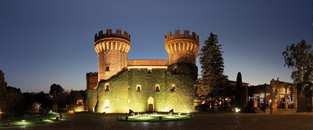
Peralada
Peralada is a medieval town in the province of Girona. It lies about 20 km from Roses. The first settlement of Peralada was in the year 500 v. Chr. By the Iberians. Its heyday had Peralada but had in the middle Ages, when Peralada became the center of the county (Comitatus Petralatensis).
By Rocabertí family, the castle was built in the 14th century, which was now converted into a casino.
During the middle Ages, Peralada became one of the most important cities in the Empordà. From this period the buildings and monuments that makes Peralada visitors come so attractive
Sights
- Castell of Peralada. The Castle of Peralada, which was built in the 14th century and was the seat of Rocabertí family, now is a casino. The castle complex includes a 33,000-square-foot park. Since May 2011, the castle can be viewed publicly on a guided tour.
- Museum Peralada. In the former Convent del Carmen is the impressive library, the Glass Museum with numerous objects made of glass and crystal and the Wine Museum with its collection of equipment from the world of wine and the wine cellar Cava del Gran Claustro, where the Carmelite monks produced the wine 500 years ago. Today the Cava del Gran Claustro is still produced there.
- Kloster Sant Doménec. The monastery of Sant DOMENEC is one of his most important legacy, from the 12th century. The remains of the Augustinian monastery was founded in the second half of the 11th century. The remains of this building contain columns and capitals carved with expressive biblical and non-religious scenes. Nowadays there are regular art exhibitions and conferences. In the evenings in the summer, many concerts will give.
- Konvent San Bartomeo. The origin of the monastery of the 1390th. From the original gothic work some architectural elements are still preserved, since the building was destroyed during the wars. The present building dates from the year 1835. Die nuns left the monastery in 1975. Today has become a residential complex of the building
- Iglesia de San Martín. The Church of San Martín was first documented in 1002. In the church, archaeological excavations have been discovered, which indicates a pre-Romanesque church from the early 9th century. The present church is neoclassical style and was built in the late 18th century
Events
- Festival de Peralada
- Festa Major

Cadaqués
Cadaqués is a small fishing village located in the Alt Empordà. The place is known worldwide by the fact that the artist Salvador Dalí owned his house there, which is now a museum. The history of Cadaques goes far back as the Iberos still possessed the lands. Cadaques was populated by sea from the Greeks and Romans.
Today, the village has a great attraction for tourists worldwide.
Port Lligat-House of Salvador Dalí
The museum is one of the most visited monuments of Cadaques. This was the place where Salvador Dalí found his inspiration over years. In 1997 his house was made available to the public. Inside the house, visitors will find the private sleeping quarters, his studio and a large library.
Church Santa María
The church of Santa Maria is a late gothic white church. The church has a nave with side chapels and polygonal apse with seven sides. The bell tower is square and includes octagonal upwards. The church is located on the highest point of the historic village, surrounded by narrow streets, which give Cadaqués special charm.
Events
- Festival Internacional de Música de Cadaqués – Cadaqués





